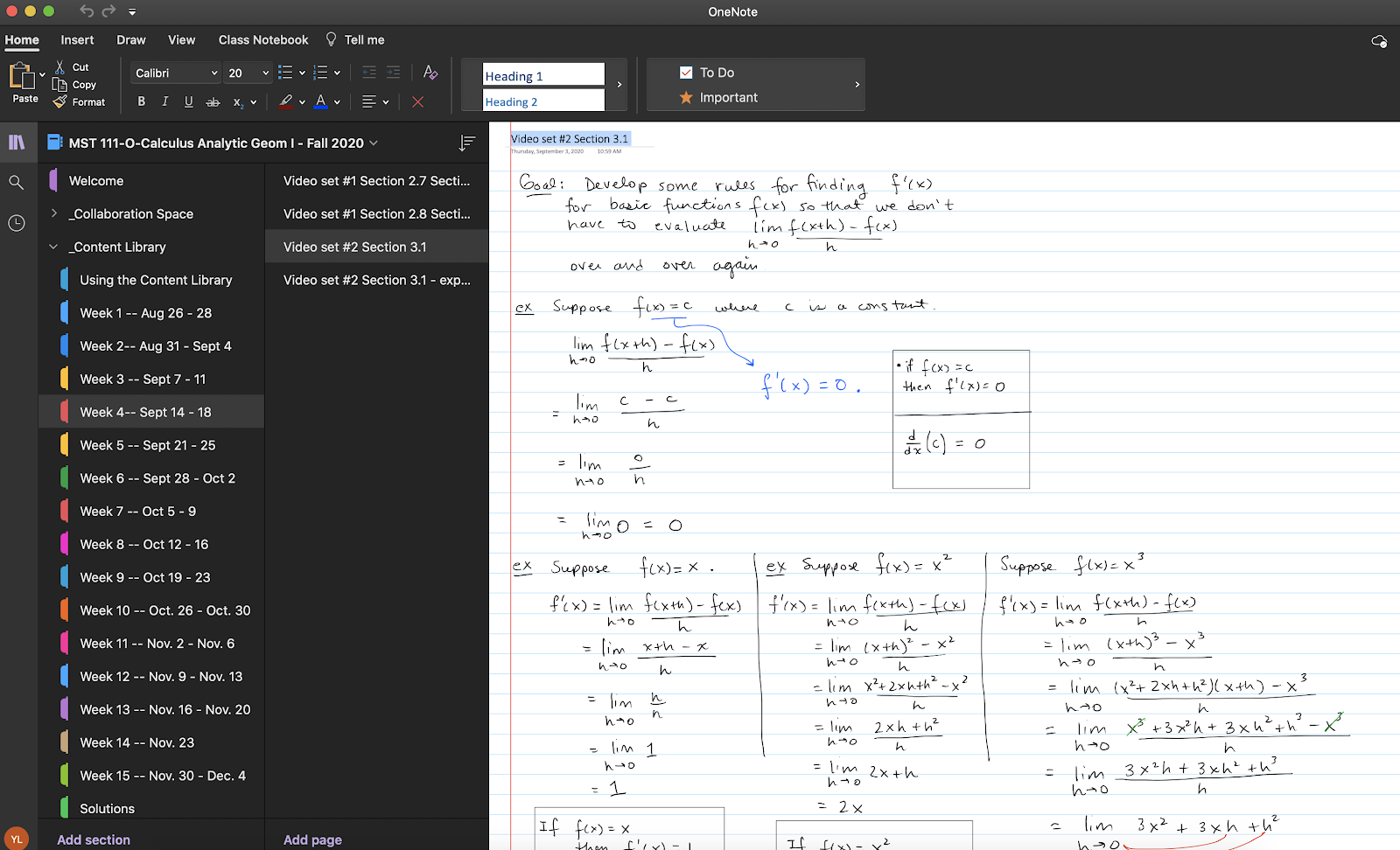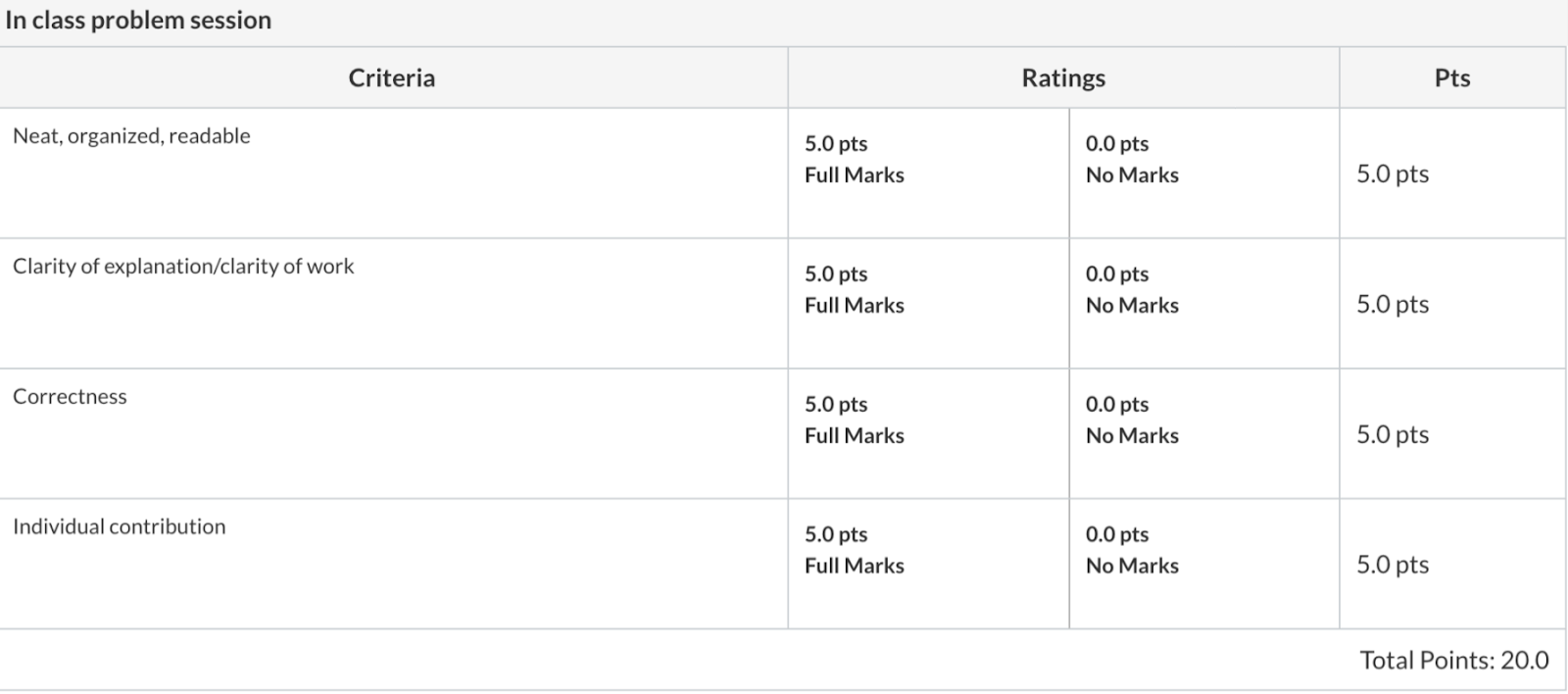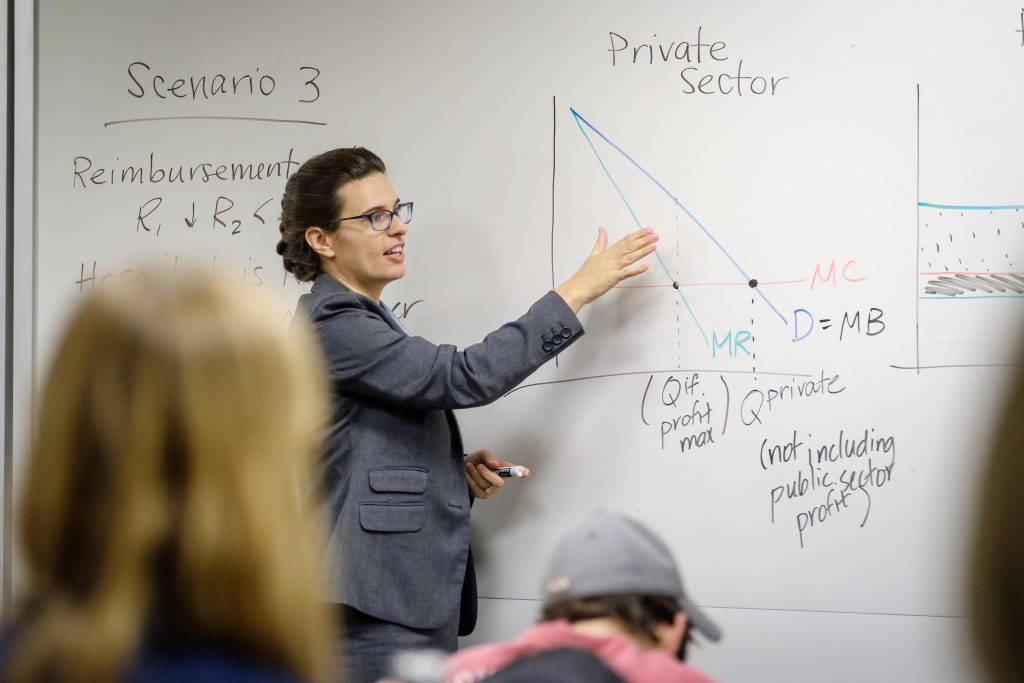Shared Spaces: Whiteboarding In Online Courses
*this post is co-authored with Amy Archambault, Instructional Designer in the Office of Online Education, and Lynne Yengulalp, Assistant Teaching Professor in the Department of Mathematics and Statistics.
For many, a challenging element of switching from in-person to online teaching has been the loss of the whiteboard. The act of teaching can feel unmoored without whiteboards on the wall and a large pile of dry erase markers at the ready. In this post, we reflect on the pedagogical purposes served by whiteboards, consider one particular digital platform and its application in a Calculus I course, and point you toward detailed technical steps should you decide to try this out for yourself.
Whiteboards — A Swiss Army Knife of Academic Technology
We know that we are not alone in our love of whiteboard spaces nor in our desire to find effective alternatives that work in an online classroom environment. When looking for potential solutions, it’s good to articulate what we expect a whiteboard to do in the classroom. On the surface, whiteboards are just blank two-dimensional spaces, about as low-tech as academic technology can get. For that fact though, so is paper in a notebook. But both are central to the efforts of teachers and learners to convey and capture ideas, demonstrate understanding, and collectively construct knowledge. So, what is it that whiteboards are expected to do? Here are some needs satisfied by a whiteboard, though certainly others can add more.
For the instructor, whiteboards are…
- a place to write the day’s plan.
- a place to depict ideas graphically and numerically.
- a place to capture key points in discussions and ideas for the day.
- a place to map connections between ideas.
- a way to slow down the pace of the class.
Whiteboards are a bi-directional space for teaching and learning. They are…
- a space to involve students in the explaining of content and the practicing of problems.
- a place for students to work individually or collaboratively and make their work visible to others.
- a tool that allows for spontaneity and agility in response to the emerging needs of a class session.
- an accessible medium for improved student note taking because the content and organization is amenable to transfer to a paper notebook
Potential Online Alternatives
A blank, shared space functions both as a physical repository of content as well as an interface for engagement in learning activities and collaborative construction of ideas. There are a number of software applications and internet platforms that provide elements of this functionality. Jamboard is an app that is part of the G-suite, accessible from a Google drive, and creates a blank digital space, a “Jam”, that can be shared. Annotate with Kami is an application with a free version that transforms static documents into an interactive interface that allows students to write on and submit math homework problems. Zoom has a whiteboard application built-in while Explain Everything is an online whiteboard application. Notability is an Apple product that allows writing on a blank digital space as well as annotation of PDF documents. In addition to these specific solutions, one that particularly excites us is OneNote. An important caveat with any whiteboard application you consider is to ensure that all students will be able to participate equitably in the work. In the CAT Fall 2020 Survey, one student shared that…
My __ professor tried to have us use __, an online whiteboard app, to solve problems in small groups during class … it was really difficult to write out equations with greek letters using a keyboard or drawing on the laptop’s trackpad. The folks with iPads and styli did not have this problem, but it was really time consuming and frustrating for folks like me who just had a laptop.
OneNote As A Whiteboard Solution
OneNote provides the full functions of a whiteboard described above, supports individual student notebook functions, and enables these whiteboard and notebook functions to work together in a coherent and organized manner. With OneNote, faculty can teach an online class session with real-time writing, drawing, and problem-solving and students can both view and contribute to that collective real-time workspace. External images can be added to the space and annotated. Attachments, links, and video and audio files can be incorporated as well. The space is accessible during live synchronous class sessions and for asynchronous review afterward. Because OneNote is structured like a notebook, each whiteboard space can be labeled and sequenced in an easily navigable way, just like a multi-subject notebook with tabbed dividers. Students can have their own private digital notebook space for taking notes, practicing problems, and submitting evidence of their work. Collaborative spaces can also be made for students to work on group assignments, either synchronously or asynchronously. These spaces, which faculty can easily view, serve as archival and retrievable artifacts of student work and learning.
As a cloud-based tool that integrates with Canvas, the writing and drawing on each page is automatically saved and accessible to students without additional steps of downloading, importing, or posting after a class session. The platform seems to work equally well on Macs and PC’s. When using a OneNote page as a whiteboard space during a live class session, it may work well to have the instructor’s web-cam on a separate device from the device used for writing. Either a separate web-cam or an external tablet, such as the Wacom One, may work well. It’s worth noting that one of us has encountered minor glitches periodically with integration and syncing of content. It may glitch when more than one person is writing on a OneNote page but closing and reopening the OneNote app or logging onto onenote.com usually fixes this. During the initial integration, Canvas usually creates a OneNote section for each student enrolled in the course when the student clicks on Class Notebook in Canvas for the first time. If it does not do this, the student can easily be added manually.
Online Whiteboard Success: Teaching Calculus 1
If OneNote sounds like it might be a helpful tool, consider beginning by using a personal Notebook to make some materials either live or ahead of time to share with your class. As you get more comfortable, you may be ready to take the plunge and create a Class Notebook. To help you imagine how you could use a Class Notebook, here is an example of how one of us used this during Fall 2020 and Spring 2021 to teach Calculus 1 as a fully online course. 30 students were enrolled in each section and the class met synchronously for 75 minutes 3 days each week. The course was “flipped” such that lecture content was recorded and accessible ahead of time and synchronous class sessions were used for collaborative problem-solving.
Step 1: Creating Asynchronous Lecture Materials
Students watch 3-4 short videos each week as an introduction to new concepts. The videos, structured like an interactive lecture with a mix of theory and practice, are created using Camtasia to record the screen while the instructor writes in OneNote. A quiz question is later inserted into the video and then the video is placed into Canvas as an assignment. The score on the quiz question is automatically recorded into the Canvas gradebook. Students report appreciating earning credit for completing the videos in this way and find it convenient to pause and rewatch. The videos give just enough introduction so that students are able to make real progress on the in-class group work. Camtasia and Kaltura are both good resources for hosting the videos as well as inserting interactive questions.
The OneNote Class Notebook is organized so that each week of the course is a “section” and there is a separate “page” of notes for each video. Below is a picture of the Class Notebook showing written notes for content covered in Week 4 of the class. In addition to watching the video, students can access these pages (read-only), and can make a copy of the page into their own personal OneNote section. This allows them to take notes on top of the instructor notes as they watch the video.

Step 2: Facilitating Synchronous Sessions
After watching the videos and taking notes, students gather for a synchronous class session which begins with announcements, greetings, and a brief introduction to the day’s problems. Students are assigned to groups, join breakout rooms, and open the corresponding group folder in OneNote where there is a preloaded problem set.

Once in breakout groups, students select roles and add that role to their Zoom name. Defining and assigning roles — motivator, recorder, justifier, questioner, and floater — has helped the groups function effectively. Since the students are working in this shared online space, the instructor can quickly scan the groups’ work and provide instant feedback on the page. This has created an unexpected improvement in monitoring and giving feedback without disturbing the group’s flow. If a longer explanation is needed, the instructor can visit the breakout room. In the physical classroom, this feedback is much more difficult as it typically requires running from group to group clumsily peering over shoulders and reading upside-down.
Step 3: Grading and Formative Feedback
With clearly defined group roles and a transparent rubric for grading the in-class problem sets (below), students generally feel that they know what to do to progress.

The group work creates the momentum for students to complete the work in proper mathematical form on their own. When students have questions, they can put their work in their individual OneNote section and the instructor can write directly on the page. This is particularly helpful during virtual office hours. One student last semester said about the classwork:
It became a stress reliever class, as I like to call it, because I always knew what I was doing and knew that if I kept at the work I was doing, I would be able to figure it all out.
If you’d like to learn more about how to use OneNote in your course, please reach out to any of us. We’d be glad to talk with you about potential pedagogical applications, or help you get a Notebook up and running. We have created a companion post on the Online Education blog describing in detail how to setup and integrate OneNote with Canvas. While we love the low-tech physical whiteboard, we’ve found that OneNote creates a shared blank digital space that has tremendous potential and versatility as well.
Subscribe
Receive CAT blog posts in your inbox.

